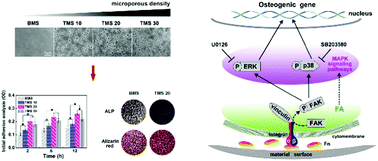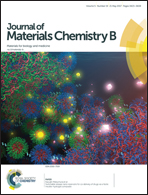Microporous density-mediated response of MSCs on 3D trimodal macro/micro/nano-porous scaffolds via fibronectin/integrin and FAK/MAPK signaling pathways†
Abstract
The microporous architecture of biomaterials/scaffolds plays a critical role in cellular behaviors of marrow stromal cells in the field of tissue regeneration, but the role of microporous density in this process and its underlying molecular mechanism are poorly understood. In the present work, a series of three-dimensional (3D) trimodal macro/micro/nano-porous MBG scaffolds (TMSs) with different microporous densities were developed to investigate the influence of microporous density on the attachment, proliferation and osteogenic differentiation of rat bone marrow stromal cells (rBMSCs), and the fundamental molecular mechanism was explored. The results demonstrated that scaffolds with micropores significantly promoted initial cell adhesion, ALP activity and osteogenesis-related gene/protein expressions, especially the one with 20% microporous density (TMS 20). We found that the appropriate microporous density modulated the adsorption of fibronectin (Fn), and in turn facilitated integrin receptor binding affinity, focal adhesion complex formation and subsequent FAK/MAPK signaling pathway activation. Based on these studies, it can be confirmed that microporous density contributes to the regulation of cellular response, which can provide a new insight into the design of future bone substitutes in a 3D environment.



 Please wait while we load your content...
Please wait while we load your content...